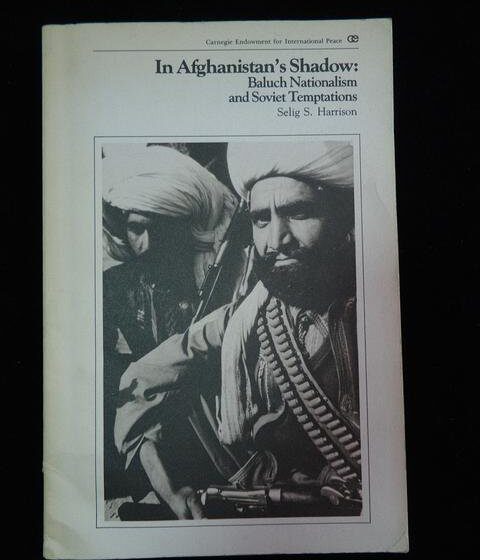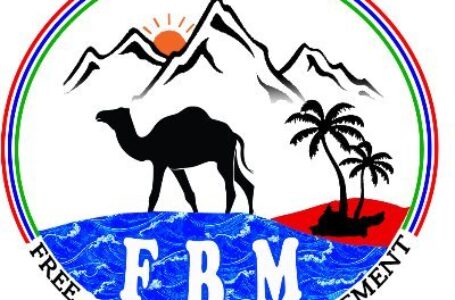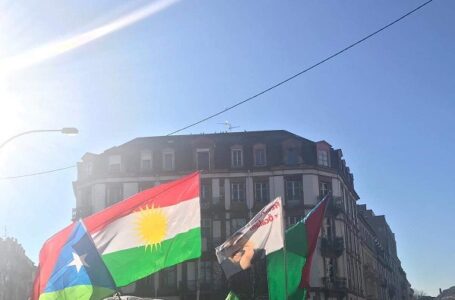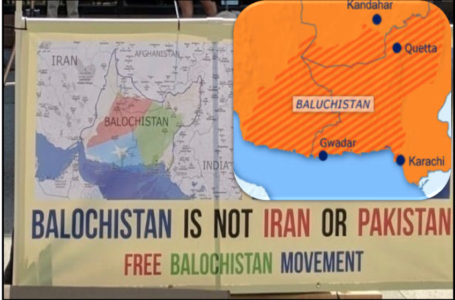Israel’s decisive Attack on Iran a Significant Opportunity for Baloch National Independence: FBM
Book Review: In Afghanistan’s Shadow: Baloch Nationalism and Soviet Temptations

Author: Selig .S. Harrison
Review: Bahraam Baloch
The late American scholar Selig .S. Harrison in this book, glimpses briefly on the history of Baloch and Balochistan. He serves a cryptic view of migrations of Baloch to the then location with multiple examples of the historians, whereas, he is in the self-complacency concerning the other historians based on Baloch migration. However, the book is a crystal-clear focus on the emergence of Baloch nationalism and the waves of insurgencies and Guerrilla warfare in both Eastern and Western parts of Balochistan – Pakistan and Iranian Occupied Balochistan.
As do others, he references the Chronicles of geology that Baloch were the kindred branches of a tribe that migrated from Aleppo (Syria) to the current location of Asia before Christ. Many historians are in disagreement with this point of view. Broadly, many of them consider the Baloch as the ethnic group evolved from the Semitic Chaldean rulers of Babylon. In contrast to that, some argue that Baloch Arabs descents others believe that they are Arians from Asian minors.
In obscure conjecture, it is said that the both, Kurds and Baloch, were under the Chaldean rulers. It happened so, that the Kurds headed towards Iraq, Turkey and North-west Persia, and the Baloch to the coastal area of Caspian Sea in 5th to 6th century. But mostly it is believed that Baloch dwelled in the Caspian Sea and the reason behind that is Balochi is linked to the Parthian and Median civilizations.
Moreover, it is mentioned that Balochi language is a mystery but it is also linked to Indo-European languages which include Farsi (Persian), Pashtu, Balochi and Kurdish.
Discussing the political unity, it is mentioned that the first unification of Baloch and motherland was held by Mir Chakar Khan Rind, whose approached boundaries of Balochistan start from Makran Belt to Marri area till Shall (Quetta) before the British Raj in 15th to 16th century. It is of no denial that he had the cultivated possession of Multan and South Punjab until 16th century. According to Justice Khudabaksh, he had an army of 4000 men.
Notwithstanding this, Baloch did not keep a political identity until the establishment of the confederacy by Mir Abdullah Khan from Ahmadzai tribe. His created boundaries spread to Dera Gazi Khan, Kandahar and Bandar Abbas but still, the task was left to a more dissent ruler Mir Naseer Khan who ruled from 1741 for half a century. To his utmost endeavouring, he managed an army of 25000 men with 100 camels and many other necessities of war. Constitutionally, he managed the parliament in a categorized way having lower chambers chosen by tribes and upper chambers of elders serving in an advisory capacity. To be sure, that Mir Naseer Khan held international treaties, such as, a tribute to Nadir Shah for helping him and limitedly once being under the hands of Suzerainty of Ahmad Shah Durrani for eleven years was also a form of a temporary treaty.
Unfortunately, the Western part of Balochistan did not have a political unity in any way as compared to the Eastern part of Balochistan. However, Dost Mohammad held the confederacy in western Balochistan but it was soon subdued and crushed by Reza Shah Pahlavi with the power of gunship helicopter and heavy artillery. Heartbreakingly, an unbearable Baloch genocide took place under such colonialists.
Coming back to Eastern part of Balochistan, there was a similar case of colonialism where Nasir Khan’s confederacy collapsed. Many consider the collapse of his confederacy was due to the British “Forward Policy” to Persia in 1871; Afghanistan in 1894 and then to Balochistan.
The Baloch Nationalism germinated since the subjugation of the Pahlavi Dynasty and Muslim League regime of Mohammad Ali Jinnah. Juxtaposing the differences in Western and Eastern parts of Balochistan, the meticulousness of nationalism is less in Western Balochistan. The reason behind that is Iran curtailed the education and Baloch culture but Pakistan has only simply ‘modernized’ the education but not the culture so far.
The same nationalistic circumstances turned to Guerrilla warfare in 1948, 1952, 1962 and going to its extremes in 1973-1977 and the currently ongoing phase of the Baloch national struggle for freedom.
Since the British Raj suppressed the Baloch nationalism and its education, the little exposure of Baloch political consciousness surged in “October Revolution” and the resistance of Mohandas K. Gandhi and Jawaharlal Nehru against British. However, the pro-Soviet activists did not turn to communism but found their roots of the nationalistic question for a revolution and it turned to armed militancy.
In 1930 great leaders came forward including Abdul Aziz Kurd the founder of (Anjumn-e-Ithad Balochistan) and Yousuf Aziz Magsi with other nationalists formed Kalat National Party. However, it demanded an independent and unified Balochistan but was, lamentably, outlawed in 1939. Many magazines and newspapers published like “Al-Baloch” which in 1933 firstly published the map of “GREATER BALOCHISTAN”.
During the partition, the Baloch already informed the British Raj that the preceding government would only inherit the New Delhi but not the Whitehall. Because Balochistan and Nepal had direct relations with Whitehall and the other princely states were dealt by New Delhi. In addition to that, when the British Raj forwarded to this area, they signed a treaty with Balochistan’s rulers which read, “The British would respect the sovereignty and independence of Kalat”.
But, heartrendingly, rather than that internationally agreed treaty, Balochistan was annexed to Pakistan, forcefully. Ghaus Bakhsh Bizenjo firstly resisted being amalgamated to Pakistan.
The annexation occurred in April 1948 when the army was sent to arrest Khan and coerced him to sign the so-called ‘annexation treaty’. Though he has capitulated, his younger brother Abdul Karim resisted against Pakistan and fled to Afghanistan to seek international support and continue armed resistance against the forcible occupation of Balochistan by Pakistan.
However, later the Khan and Pakistani government convinced him (under the oath of Holy Quran) to come on the negotiation table for a peaceful solution to Balochistan issue but when he was on his way for negotiations, the Pakistan army confronted and arrested him along with his 102 companions thus violating their pledge on Holy Quran.
One day after the Martial law the army raided Kalat and ordered the chieftains to handover their guns at a nearby police station to which Nawab Zouroz Khan Zehri, famously known a Babo Nouroz, refuse to obey the order and led his tribe to the mountains and continued resistance.
Once again the Pakistani army took the oath of Holy Quran and convinced Nawab Nouroz and his companions to opt for a peaceful solution but as usual, Pakistan did not honour its promise and sentenced the Nawab and his comrades to death. Nawab’s sentence was later changed to life imprisonment because of his ‘old’ age but his son and other friends were hanged in Hyderabad jail in 1964. Norouz died in jail a year later. It is said that one of Nouroz Khan’s colleagues took the Holy Quran as walked to the gallows to be executed. He demanded that since the Pakistani had broken their pledge to Quran hence it should also be hanged along with him.
After this many leaders planned to form Guerrilla movement against Pakistan. The surplus leader Sher Mohammad Marri later went to the mountains and in 1963 and reportedly commanded 23 Guerrilla camps. They were mostly influenced by Marxist-Leninist ideologies.
The situation occurred due to the establishing of One-Unit. In December 1964, 500 Parrari attacked the Pakistani army where high casualties occurred on both sides.
Soon after, in 1969 Yaya Khan came to a truce and agreed to withdraw the One-Unit. Thus, Yaya Khan announced a ceasefire and Bhutto agreed to the provincial government so that One-Unit broke in 1970. The government of Pakistan issued a mandate to Balochistan provincial government headed by Governor Ghaus Bakhsh Bizenjo and Chief Minister Sardar Attaullah Mengal.
But again Bhutto dismissed the provincial government on 12 February 1973. In trumped-up charges, Bhutto accused the Balochistan government of receiving support from Iraq and the Soviet Union and had 3000 soviet machine guns and 48000 rounds discovered in Iraq Embassy in Islamabad. One must keep the fact in mind that weapons, if any, were found in Islamabad but the government of Balochistan was dismissed.
Not only Bhutto had dismissed the Balochistan government but under the pretext of arms recovery but with Bhutto has Prime Minister Pakistan army launched brutal military offensives in Balochistan. In retaliation to Pakistan’s offensives, in early April 1973 after six months Baloch guerrillas began to attack Pakistan army. The army in return started shelling and bombing villages of Marri Baloch people in Kohistan Marri region of Balochistan.
Later, however, when the Baloch parari (Sarmachars) despite being less in number were having an upper hand against Pakistan army, the Shah of Iran sent cobra helicopters and Iranian pilots to rescue the trapped Pakistan forces. Pakistani army Lieutenant General Arbab Jahanzeb acknowledged that the situations were out of control in 1974 in Chamalang and that the Iranian support came handy as its Cobra helicopters killed at least 15,000 Marri Baloch fighters.
This was the time when thousands of Marri Baloch migrated to Afghanistan and BPLF (Baloch Peoples Liberation Front) was founded, guerrilla fighters were headed by Mir Hazar Khan Marri and other regional commanders who continued to resist Pakistan army in Balochistan. BPLF had founded its monthly “Jabbal” circular.
Baba Khair Bakhsh Marri, Sardar Attaullah Mengal and Mir Ghaus Bakhsh Bezenjo who shared common ideology about Balochistan but after their release in 1977 their activities diverged and they parted ways. Bezinjo and Mengal favoured parliamentary politics within the framework of Pakistan but Nawab Khair Bakhsh Marri was not convinced with their approach and favoured armed resistance. He supported the Baloch Peoples Liberation Front (BPLF).
The nationalistic movement of Baloch Peoples Liberation Front (BPLF) was in progress against Pakistan. Though firstly, as they mentioned in their monthly “Jabbal” manifesto, that they wanted to liberate all the nationalities of Pakistan and clearly said that struggle for western Balochistan is not feasible with the situation of this regime.
At the same time, unarmed political organizations such as BSO (Baloch Student Organisation) were working too in the region. Though later it was divided into two parts. But both continued their struggle and published their monthlies, as, “Girokhk”, “Sangat” and “Baam” these were of BSO and similarly “Pajjar”, “Labzank” these were owned by BSO-Awami.
The case of nationalism in Iranian occupied Balochistan where the first confederacy held by Dost Mohammad Baloch was defeated, in way of forgery, by Shah of Iran in the year 1928. On the other hand, the first guerrilla fighter Dad Shah emerged as one of the stalwarts of Balochistan independence. Though at first, he was not fighting against Iran for a unified and independent Balochistan he instead did what Robbin Hood had done. To the prosperity of poor Baloch, he looted the tycoons and distributed the looted wealth to the poor Baloch.
However, later his guerrilla warfare took a new turn and he then continued war for an independent Balochistan. His most attacks were on Persian police and military. Once he attacked a convoy of police resulting in high casualties after ten months of this attack he was martyred. However, before his martyrdom, Iran had put a bounty of $10,000 on him dead or alive. At the time of insurgency, his hideouts were in Ahuran Mountains in Iranian occupied Balochistan.
After Dad Shah, the Persian colonialists arrested his brother Ahmad Shah and later executed him. Some say Dad Shah’s brother and other family members were arrested by Pakistani forces and handed over to Iran. The execution of Ahmad Shah ignited another wave of resistance lead Jumma Khan Baloch, also known as JK Baloch, who at first took refuge in Damascus, Syria and formed the Balochistan Liberation Front (BLF) in 1964 to wage an armed struggle against Iran.
Similarly, few unarmed organizations were working for provincial autonomy and demanding the fundamental rights of Baloch people. In Iranian occupied Balochistan, the government under Article 15 of the constitution had banned the Balochi language at Schools, Universities and all other educational centres.
In addition to that Balochi Cultural clothes, magazines, and hence every aspect of the Baloch history and culture were outlawed sans any significant reason. This was seen as Persianisation of the Baloch values.
Accurately this book in a precise statement talks about the Baloch Nationalism, its emergence, hurdles and impediments, modus operandi, unity, and somewhat the suggestions of further improvements, in Western and Eastern parts of Balochistan. Apart from that the support of few countries for armed struggle and their political influence is also discussed thoroughly.









